Calcata
Today in Tuscia there are some villages that are at risk of disappearing due to seismic or weather events. These villages are protected from the morphological structure of their site for centuries because they are placed on high rocks. The first inhabitants selected these places because here they dominated the surrounding area.
Civita di Bagnoregio is certainly the most famous village, but also Calcata risks the same fate. Calcata is a small centre of Tuscia that dominates the Treja valley. The Treja is a river that is born near Lake Bracciano and flows into the Tiber.
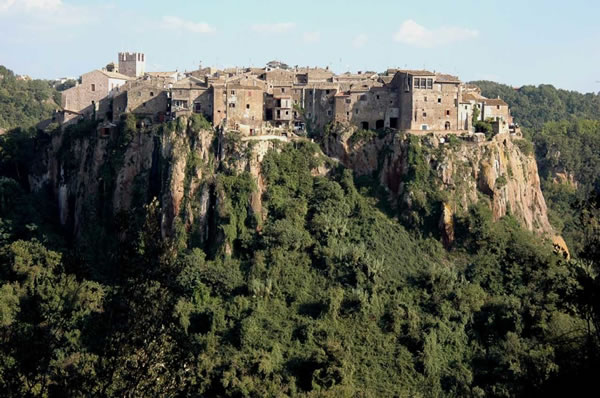
Old Calcata – Panorama
The history of Calcata abandon is different from that of Civita. The 1908 Messina earthquake destroyed the Sicilian city and damaged buildings of several towns in the rest of Italy: a law of 1935 imposed the abandon of these sites including Calcata. So the inhabitants abandoned the village built on a cliff and built near a new Calcata.

Calcata – Gate
At the beginning of the twentieth century, time stopped at old Calcata when it became an uninhabited village for several decades. In the sixties, who wanted to live in a community of human sizes rediscovered it. The new age artists and artisans bought the houses by then of little values after that commissioned studies to reassure the geological stability of the Calcata cliff: so in the village new homes could not be built longer and the cars could not pass.

Old Calcata – Panorama
The history of Calcata's territory begins in the Bronze Age. In the 15th century BC, the area was inhabited by Falisci - an Italic people to whom the Etruscans joined about 10th century BC -. The ruins of their settlings are at Narce, Pizzo Piede and Monte Li Santi: the daily life took place on Narce hill; the City of the Dead was at Pizzo Piede and a great sanctuary was on Monte Li Santi. There is a huge monolith with steps carved along the path leading to the necropolis of Pizzo Piede; but it is not yet possible to know its meaning and function with certainty.
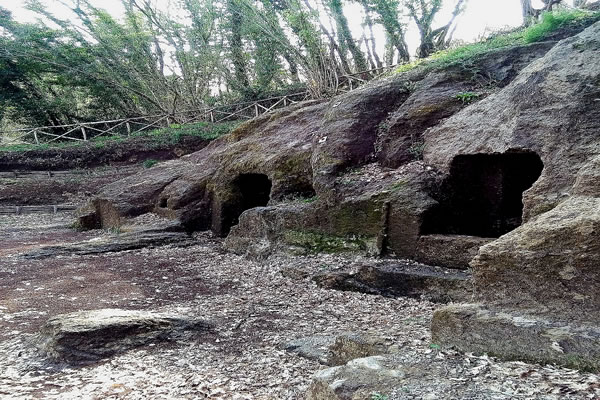
The City of the Dead was at Pizzo Piede
An epigraph with the name of the ancient falisca town was discovered at Narce during archaeological researches: Thevnalthia. About 300 votive masks have been found.
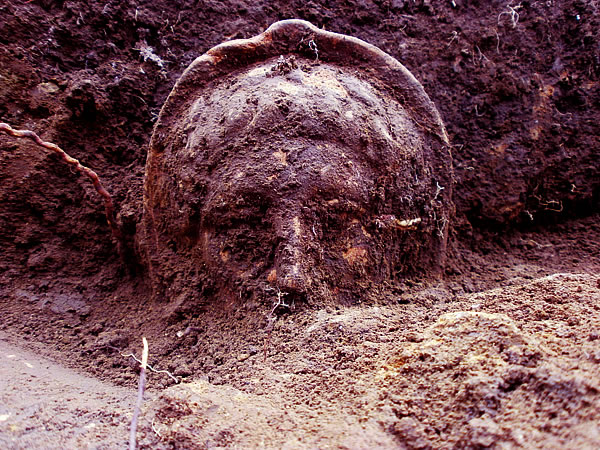
Monte Li Santi, Treja valley – a votive mask found during archaeological researches in 1985 - Archaeological Museum of Mazzano Romano
In 1985 other archaeological researches at the Treja valley discovered a sanctuary at the foot of Monte Li Santi with the access toward the river. The archaeologists found a little well where the ancients thrown the offers (perhaps the sacrificial rites were held here) and some statues representing the "mothers". They are terracotta sitting women figures that rock babies and suggest that the rituals connected with maternity cult and therefore the offers to the "mothers" were propitiatory of fertility.
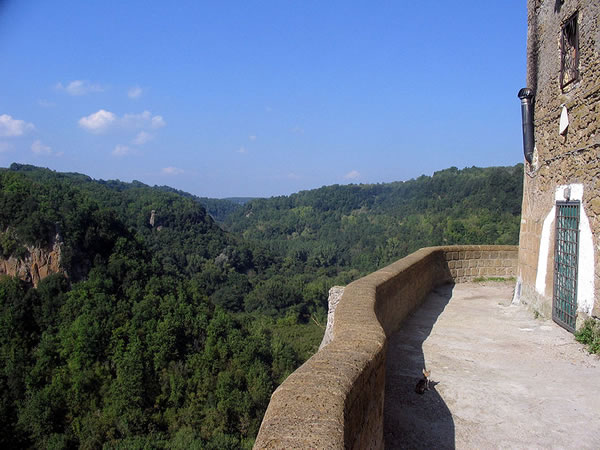
View of Treja valley from Calcata
In the 10th century BC Calcata was conquered by the Romans (the traces of this passage were not found yet) as the other Faliscan cities. Around the year 1000 the town was a fortress, owned by the Abbot of S. Gregorio al Celio, where the agricultural products of the district flowed to be distributed to the poor in the deacons of Rome.
The village has a decisive medieval imprint. During the period of the struggle for investitures the events saw the Sinibaldi and Anguillara families contend its control until the property passed to the Dukes of Rignano, a branch of the Massimo family.
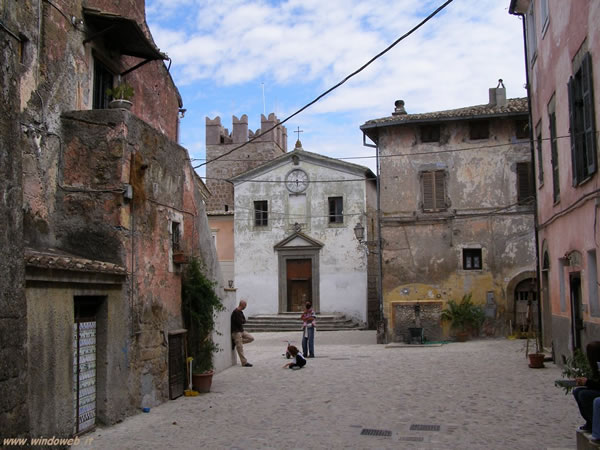
Calcata – The SS. Name of Jesus Square and Church
Only the Baronial palace (it built by the Anguillara family and restructured in the eighteenth century) and the Renaissance Church of the SS Name of Jesus stay today. There was a particular relic in this church: the Jesus's foreskin. The relic preserved in a gold globe that stole in 1984.
According to tradition Carlomagno took this relic in the Holy Land and donated it to Pope Leo III. It preserved in the Vatican until a Lanzichenecco transported it to Calcata and here he hid it in a cave. The Roman Curia has always considered this relic with prudence - though it was the only rest of the Jesus's body (it was cut off when he was circumcised in the Temple)-, and had taken it out of the church without never made too much pressure to find it.
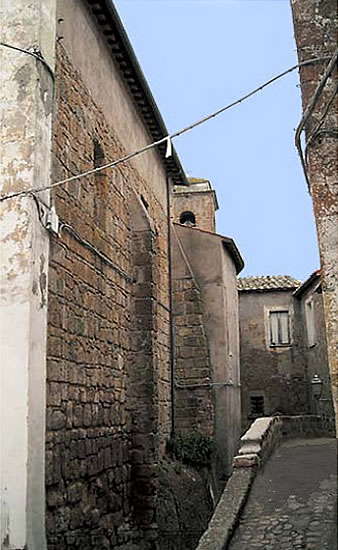
Calcata – The right side of SS. Name of Jesus Church
As the church is near to the Baronial palace, it had the function of a palatine chapel for some centuries, although the presence of the famous relic from the sixteenth to the nineteenth century made it a destination for pilgrimages from all over the Christian world. For this reason it was decided the complete restoration of this church in the 17th century, but stripping it of the medieval religiosity atmosphere that is in other villages near Viterbo.
To better understand the history of this site you need to know that the popes wanted the restoration of this church and fed the worship of the relic, granting the plenary indulgence to those who went there on pilgrimage and left considerable alms.
The restoration included in the former medieval church a part of the Anguillara Renaissance palace. It has an architectural continuity on the left side of the church and the medieval walls with the new chapel made to the side of the presbytery on the right side. Inside the church there are a beautiful eighteenth-century cycle cycle of Christ's Story in white stucco , a tabernacle of the fourteenth century, a baptismal font of marble and an aquasantier with the symbol of Anguillara.
On the square there is also the entrance door to the Baronial Palace, the most important building in Calcata and today the seat of the Valle del Treja Regional Park.
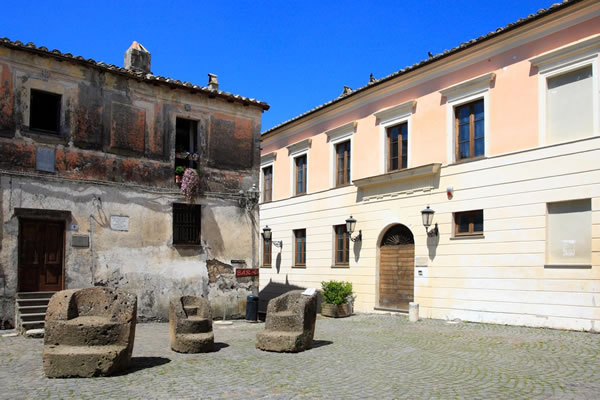
Old Calcata – the Anguillara Baronial Palace
The urban layout of Old Calcata is medieval: a lot of houses date back to 1200 and look out on the lanes and alleys that evoke stories like "The street of secret gate" so called because it led to a small gate that -from the western side of the fortress - allowed to arrive in the below valley to escape or get victuals during the sieges. Today on "The street of secret gate" there are the shops of artisans that work and live in Calcata. Near a puppet shop there is the access to go down in the hypogeum that opens onto the valley that surrounds the village.

Old Calcata - a typical alley
All Calcata streets start at Piazza Vittorio Emanuele II, where there are three tufa thrones made by Costantino Morosin in the eighties. He realized a work called "The natural room" too, it is visible in the woods of Fonte Viva inside the Treja Park.
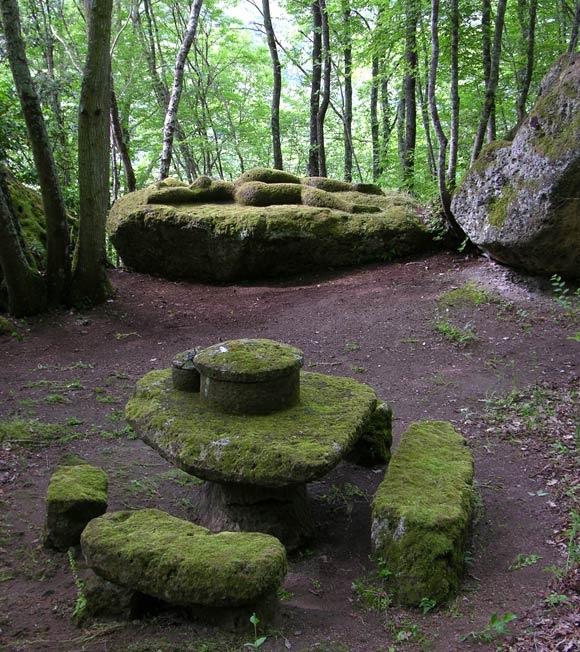
Costantino Morosin - 'The natural room', 1996
The last stop of this itineary is the Portuguese-Massobrio Garden. It was born from an idea of the Paolo Portoghesi architect, one of the artists who decided to live in Calcata in the 1960s. The botanical garden is not very large (three hectares) and has an unpredictable architecture of the Roman baroque with native plants.
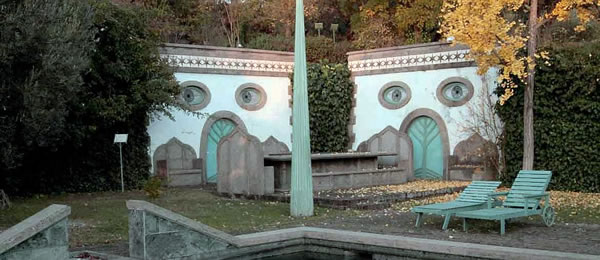
Calcata - Portoghesi-Massobrio garden
by M.L. ©ALL RIGHTS RESERVED (Ed 1.0 - 06/11/2017)



